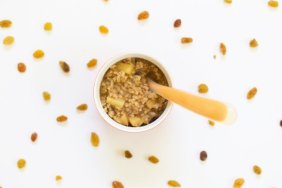Baby Constipation – It’s heartbreaking when baby is constipated.
Your baby hasn’t had a bowel movement for 3 or more days – is this normal or is this constipation? Your baby’s infrequent bowel movements are hard and dry – is this normal or is this constipation? Find answers to these questions and learn all about constipation and babies.
There are many causes of infant constipation. One of the most common causes of constipation in babies is the introduction of solid foods.
Common Causes of Infant Constipation are:
- Introduction of solid food(s) – breastfed babies may be more prone to constipation when solid foods are introduced. This is because their tiny tummies are used to processing the easily and highly digestible mother’s milk
- Diets low in fiber
- Diets of excessive dairy products (yogurt, cheeses, milk)
- Foods such as Bananas, Applesauce, Cereals, Breads, Pasta and White Potatoes may contribute or cause constipation
A change in diet usually relieves a baby with constipation. The following tips may also help the constipated baby get things “moving”.
Remedies and How to Treat Constipation in Babies
There are many things you can do to help relieve baby’s constipation. You can change baby’s feeding pattern and/or engage in some physical exercises.
Exercises to Help Relieve Infant Constipation include:
- Tummy Massage – Gently massage and rub baby’s tummy in a clockwise direction. Place your hands at baby’s navel and massage in a circular motion, moving your hand(s) out and away from the center of baby’s belly.
- Bicycle Legs – Place your baby on her back and lightly hold her legs in a half-bent position. Gently begin to move your baby’s legs as if she is riding a bicycle. Alternate “Bicycle Legs” with Tummy Massage. *”Bicycle Legs” also may help to relieve a baby who is gassy.
- A Warm Bath – Some medical professionals suggest giving your constipated baby a warm bath. The thought is that this may help relax baby and “get things moving” again. Give a tummy massage as you are drying baby.
Relieving Constipation in Babies Younger than 4 Months:
Try giving one to two ounces of diluted fruit juice such as grape, prune or apple-prune twice daily and practice some of the above exercises. (Always consult your pediatrician about the appropriateness of new foods/liquids to help alleviate constipation) Learn about Fruit Juice in your baby’s diet.
Relieving Constipation in Babies 4 Months to 12 months + by Changing the Food Diet
Adding more fiber to baby’s diet may help get things moving again. Try strained foods that contain high fiber such as:
For older infants who are just beginning solid foods, you may want to avoid baby foods such as rice cereal, applesauce and bananas as these may aggravate constipation.
Get the BRAT Out!
If your baby is constipated, reverse the BRAT diet
The BRAT diet is used for the treatment of diarrhea in infants because these foods help firm up stools. An easy and natural way to remember how to help alleviate baby’s constipation is to cut out the foods that contribute to it! BRAT stands for
Bananas,
Rice,
Applesauce and
Toast
If you ever forget which foods to cut out, remember BRAT and cut out those foods!
Barley or oatmeal cereals, prunes, peaches, plums, apricots and most vegetables are preferred when baby has constipation.
Juices are helpful, especially apple or prune, but use in moderation, as they are not as nutritious for babies as formula or breast milk.
Why can I give my baby apple Juice but NOT applesauce when baby is constipated?
There is a difference in the amount of sugars and pectin in apple juice and applesauce:
Apple juice contains more sugars and liquids so it helps relieve constipation.
Applesauce is the whole of the fruit. It may contain a higher level of pectin – which firms up stools and may thus lead to constipation.
“Apple juice also has a mild laxative effect that may help provide relief from constipation commonly experienced by little ones.” About Apple Juices
Apples contain pectin, which will add bulk to your stools, and their cleansing action will encourage bowel movements. They have a laxative effect yet are also used for to help people get back on a regular diet after suffering bouts of diarrhea.
The pectin in the apple fiber apparently is why whole apples will firm up bowel movements. Think of Kaopectate – a popular over-the-counter diarrhea remedy. Kaopectate , actually contains an oxidized form of pectin. Also, that same fiber pectin is what dietitians have been telling us for decades is necessary to keep us regular and to prevent constipation. While it will help prevent constipation by helping to keep the bowels regular, it will not help alleviate constipation.
When it comes to bowel regularity, apples contain two types of fiber; insoluble and soluble. The insoluble fiber works like roughage, while the soluble fiber (pectin), which is found primarily in the skin, acts as a stool softener by drawing water into the stool and increasing stool bulk. Because pectin firms up an excessively loose stool, it’s also used to treat diarrhea. For more information see: US Apple Association
Resources & Learning More:
![]() Remember, always consult with your pediatrician regarding introducing solid foods to your baby and specifically discuss any foods that may pose allergy risks for your baby.
Remember, always consult with your pediatrician regarding introducing solid foods to your baby and specifically discuss any foods that may pose allergy risks for your baby.
Constipation in Breastfed Babies and Formula Fed Babies
When solid foods are introduced, breastfed babies may become truly constipated while formula fed babies may struggle more frequently with bouts of constipation.
Breastfed babies are rarely constipated as breast milk is almost 100% completely digested and utilized by baby’s growing body. Breast milk leaves little “leftovers” to cause constipation. Many breastfed babies do have infrequent bowel movements however this does not mean that they are constipated.
Formula fed babies tend to battle constipation more often than their breastfed counterparts. Unlike breast milk, formula is not as easily digested nor is it as completely absorbed and used by a baby’s body.
Rice cereals, bananas, and applesauce are some of the most binding foods around and are common causes of constipation.


